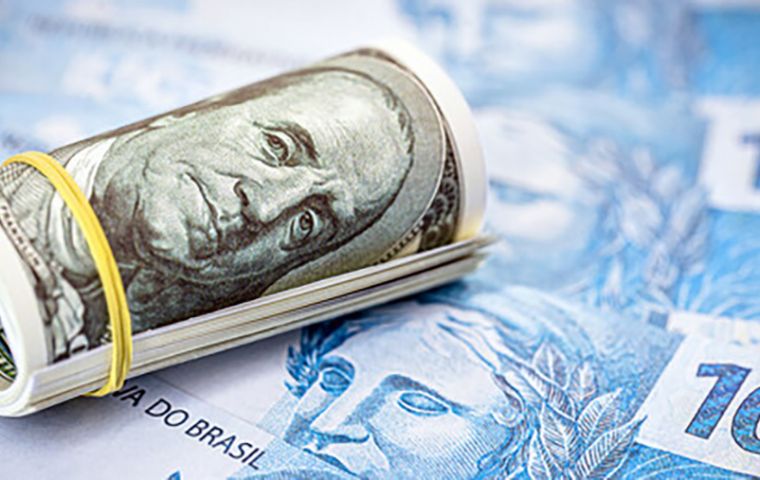MercoPress. South Atlantic News Agency
Trump's measures make dollar rise in Brazil
 Emerging markets such as Brazil were hit hard by developments in the US
Emerging markets such as Brazil were hit hard by developments in the US The quotation between the Brazilian real and the US dollar rose Friday to US$ 1 / R$ 5.83 after China announced retaliatory 34% surcharges against US President Donald Trump's tariffs, which fueled fears of a global recession, triggering turbulence in financial markets.
Brazil’s Ibovespa stock index dropped 2.96% to 127,256 points, its worst day since December, mirroring a broader decline in global markets, including the US, which saw its worst week since March 2020.
Emerging markets, including Brazil, were hit hard by this, compounded by a robust US jobs report (228,000 jobs added in March) signaling delayed Federal Reserve rate cuts and a drop in Brent crude oil prices to $64, the lowest since 2021, due to anticipated lower US demand.
The value of the US currency is at its highest since March 10, when it closed at R$ 5.85. It was also the dollar's biggest daily rise since November 10, 2022, when the currency had risen 4.1% in just one day.
The fall in the international price of oil also hit commodity-producing countries. The barrel of Brent crude, used in international negotiations, closed at US$ 64, the lowest level since 2021. Again, there were fears that demand in the United States would fall after Trump's tariffs.
On a brighter note, Brazil’s trade balance rebounded in March with a surplus of US$ 8.15 billion, the second-highest for the month historically, up 13.8% from March 2024, the Ministry of Development, Industry, Trade and Services (MDIC) announced Friday.
Exports reached $29.18 billion (up 5.5%), driven by higher coffee prices, the start of soybean and corn harvests, and increased sales of beef, cellulose, and copper ore.
Imports rose to $21.02 billion (up 2.6%), boosted by purchases of machinery, engines (up 45.9%), medicines, and fertilizers. Export volumes grew 5%, with agriculture leading at 10.8%, while manufacturing saw a 9% increase, aided by recovery in Argentina.
The extractive sector lagged, with a 10.6% drop in volume due to oil platform maintenance. The Ministry of Development forecasts a 2025 trade surplus of $70.2 billion, though Trump’s tariffs and China’s retaliation, not yet factored in, may alter this outlook.
Last month, Brazil exported US$ 29.177 billion worth of goods, up 5.5% from the same month last year and the third best March since 1989, when the historical series began, second only to 2023 and 2022. Imports totaled US$ 21.023 billion, up 2.6% on the same comparison and also the third highest figure in history, second only to 2023 and 2022.
On the import side, purchases of engines, machinery, medicines, vehicle components, fertilizers, and chemicals rose. The biggest increase came from machinery and engines, which went up by 45.9% from March last year.
Last month, the volume of goods exported rose by 5%, driven by the start of the harvest for various products. Prices rose by just 0.4% on average compared to the same month last year. In terms of imports, the quantity bought rose by 4.2%, driven by economic growth, but average prices fell by 1.5%, reflecting the fall in the value of commodities (primary goods with an international price). (Source: Agencia Brasil)




Top Comments
Disclaimer & comment rules-

Read all commentsSad for Brazil. On the other hand, a beer now costs me around 25 cents (US). Cheers !
Apr 07th, 2025 - 02:06 pm 0Commenting for this story is now closed.
If you have a Facebook account, become a fan and comment on our Facebook Page!